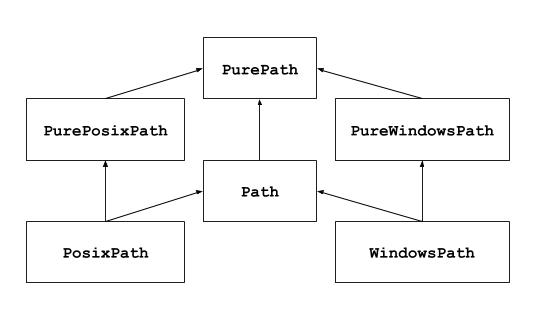python2 공식 지원이 종료됨. python 3.4부터 pathlib라는 경로 모듈이 추가되었는데, 기존의 os.path와 어떻게 다르고, 어떻게 써야 하나 익혀두자.
Pathlib - 객체 지향 파일 시스템 경로
객체 지향 파일 시스템 경로, 즉 파일을 객체로 관리하겠다는것 같음.
아래 그림은 Pathlib 내부 객체들의 상속관계로, 가장 기본적인 객체는 PurePath임을 알 수있음.
대략적인 객체간 의미와 관계를 알기 위해 라이브러리를 뜯어봄 -> pathlib.py

객체 선언 전, 경로 파싱을 위해 _Flavour이라는 객체를 정의하고, 이를 각 os에 따라 나눠놓은 것으로 보임. _PosixFlavour(_Flavour), _WindowsFlavour(_Flavour)
PurePath 는, 아래 설명과 같이, 파일시스템 I/O를 제외한 단순 경로 접근 명령만을 취급하는 것으로 보임.
PurePath represents a filesystem path and offers operations which
don't imply any actual filesystem I/O. Depending on your system,
instantiating a PurePath will return either a PurePosixPath or a
PureWindowsPath object. You can also instantiate either of these classes directly, regardless of your system.
Path 는, PurePath를 상속받으며, system call을 사용할 수 잇는 것으로 보임. 대충 찾아보니, 파일시스템 I/O에 관련된 메소들을 사용 할 수 있는 것으로 두 객체가 나뉘고, 내부적으로 os에 따라 PosixPath 또는 WindowsPath 객체로 나눠주는 것으로 보임.
정리하자면, PurePath는 아래와 같은 상황에서 쓰일 듯.
- Unix 환경에서 Windows 경로를 다룰 때. (vice versa)
- Os 파일 시스템에 접근하지 않고, 경로만을 다룰 때.
Path represents a filesystem path but unlike PurePath, also offers
methods to do system calls on path objects. Depending on your system, instantiating a Path will return either a PosixPath or a WindowsPath object. You can also instantiate a PosixPath or WindowsPath directly, but cannot instantiate a WindowsPath on a POSIX system or vice versa.
차이점
os.path 와 Pathlib의 가장 큰 차이점은, 경로를 문자열로 다루냐, 객체로 다루냐 차이인데, 모든 것이 객체로 이루어진 python 인 만큼, Pathlib가 자연스러운 모듈이며 객체 내부적으로 정의된 연산자를 사용할 수 있어 경로에 있어 더 자연스러운 표현이 가능함.
기본적인 사용법은 알아야, 나중에 쓸 일이 있으면 찾아보지 않고 쓸 수 있으니 대충정리해보자.
1. 탐색
논리적 경로와, 절대 경로와의 구분을 잘 해야 함. 논리 경로 상에서, 앵커나 빈 경로는 넘어갈 수 없음. 코드상으로 경로 탐색에 사용할 수 있는 것은, .parent, .parents, .iterdir() 등이 있음.
상위 디렉토리로 넘어가기 위해선, .parent를 사용하나, 사용하기 전 절대경로로 바꾸고, 현재 경로가 디렉토리이면, .iterdir()를 통해 자식 경로를 얻을 수 있음.
from pathlib import Path
p = Path('.') # PosixPath('.')
p.resolve() # os.path.abspath()
p.resolve().parent
list(p.iterdir()) # iteration, list 변환, = os.listdir()2. 연산자
연산자를 사용하여 경로 조합 가능.
from pathlib import Path
p = Path.home() # os.path.expanduser()
p_sub = p / 'foo' / 'bar' # PosixPath('/Users/kyuu/foo/bar')
p_sub = Path(p, 'foo', 'bar') # os.path.join() 모방참고
- Python3 Documentation : https://docs.python.org/ko/3/library/pathlib.html
